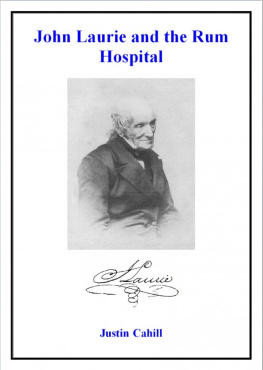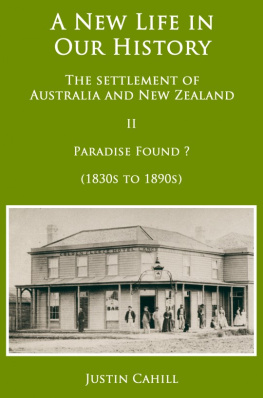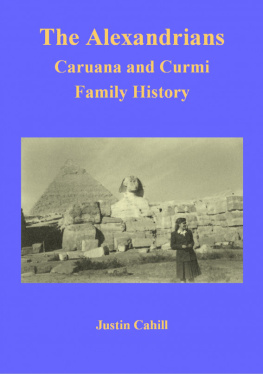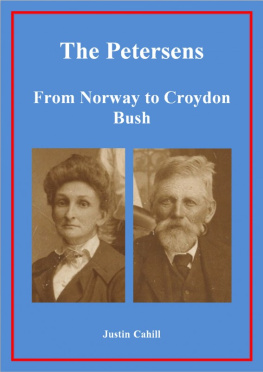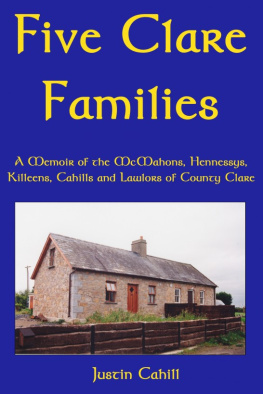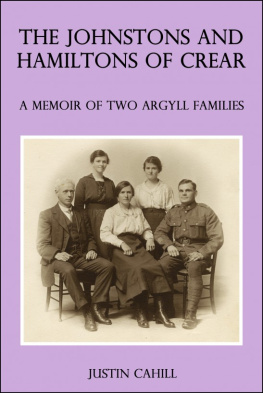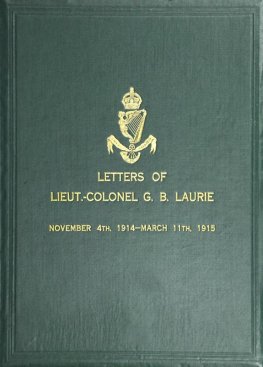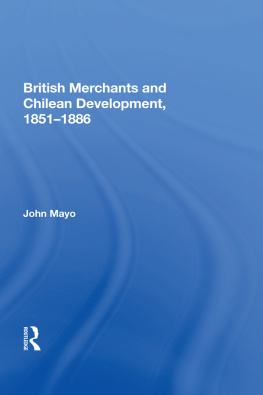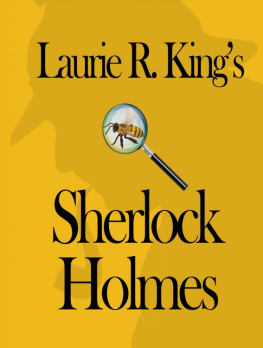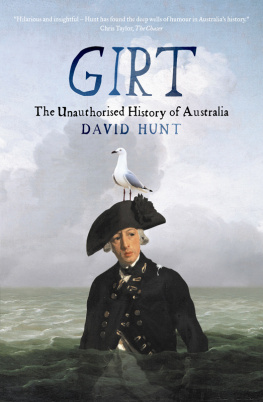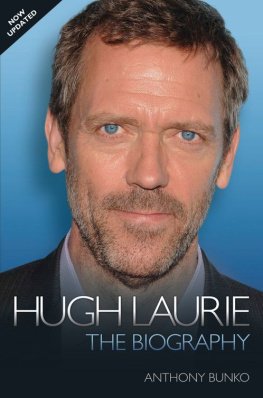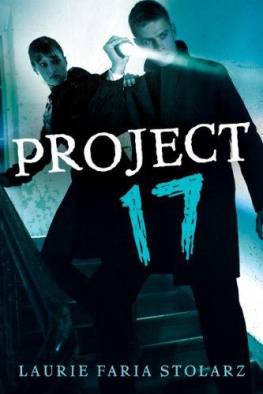JOHN LAURIE AND THE RUM HOSPITAL
Justin Cahill
Smashwords Edition
Copyright 2016 Justin Cahill
Allrights reserved. The author asserts themoral right to be identified as the author of this work. This ebook may not bereproduced by any means in any form without the copyright holderswritten consent.
All inquiries to Justin Cahillat
PO Box 108, Lindfield, 2070
New South Wales, Australia
or e-mail to jpjc@ozemail.com.au
Cover: Photograph reputably of John Laurie taken atFreeman Bros Photographers, George Street, Sydney. Below that isJohns elaborate signature, taken from a deed dated 12 May1819.
Preface
This year marks the bicentenary of theopening of the Rum Hospital in Sydney. The Hospital earned itsname from the partial monopoly over the import of rum GovernorMacquarie granted to three local merchants, Alexander Riley,Garnham Blaxcell and DArcy Wentworth, in return for buildingit.
Previous accounts of the Hospitalsconstruction focus on Macquarie, the three merchant-contractors andtheir disputes. This is a short account of John Laurie, thecontractors clerk of works. He was responsible for, among otherthings, selling their rum.
John Laurie has been largely forgotten byhistory. Yet he was one of the emancipist traders who helpeddevelop Sydneys infant economy and transform it from a penalcolony into a free settlement.
John aspired to be one of the Colonys greatmerchants. I think he hoped to emulate Wentworth in overcoming hiscriminal past and making his fortune. Johns purchase ofAshfield Park was the culmination of this ambition. But hisaffairs suddenly collapsed and he left for New Zealand in about1839.
i
John Laurie was born in 1785 near St GilesChurch at Cripplegate in London and Shoreditch. He was, familytradition has it, of French descent and grew up around Hoxton. Hecould read and write and gave his occupation as a perfumer.
By the early 1800s, he seems to have fallenon hard times. He joined a gang who posed as a family, rentedfurnished homes, stole the contents and pawned them. He tried tohide incriminating evidence by throwing the pawnbrokers receiptsin the toilet, but they were found and he was arrested.
John was convicted at the Old Bailey inApril 1804 and sentenced to 7 years transportation. He left Englandin January 1806 on the Fortune, which was part of the convoythat brought Governor Bligh to Sydney. John later recalled thatwhen he arrived in Sydney, the town was but a few boats on thebeach.
John spent some time working with the Town Gang, the convictsassigned to public works in Sydney, and driving the governmentsbullock carts . He then became the clerk to Richard Atkins,the Colonys Deputy Judge Advocate.
Atkins had adopted Sarah, the daughter ofone of his lovers, Ann Bockerah. Ann is believed to have been thewidow of Solomon Bockerah, a convict who arrived with the SecondFleet on the Scarborough. Ann died in 1791, leaving Sarah anorphan.
John and Sarah struck up a relationship.They had their first child, Astley, in about 1808. They had 11other children. The family lived at various addresses in the Rocks.Most of their children were baptised at St Philips.
John appears to have been an energetic, cando kind of man. He made a good impression on people in authorityand was able to extract favours from them. Sydney was the perfectplace for someone like him to get a start. There were opportunitiesto make significant sums of money if you had the right contacts andwere prepared to work smart.
ii
Atkins and John both lost their positionsafter the Rum Rebellion in 1808. The rebel administrationeventually restored Atkins as Deputy Judge Advocate as there wasno-one else suitable for the position. John also bounced back.Foveaux appointed him as Principal Overseer of the Town Gang in1809. Paterson granted John a conditional pardon and land at theRocks. He also granted Sarah land at Airds, which the Lauriescalled Pimlico. These land grants were crucial to theColonys development as they provided many early settlers withtheir first opportunity to become financially independent.
Other opportunities included public workscontracts and the rum trade. John became involved in both when hewas hired by the contractors Macquarie engaged to build the newSydney Hospital, later known as the Rum Hospital.
In 1811 John resigned as principle overseerto work for Wentworth, Riley and Blaxcell. Wentworth was, by thistime, the Colonys Principal Surgeon and a wealthy merchant.
Riley was born in London in about 1778. Hewas a shrewd and capable businessman, but also excitable,emotional and highly imaginative, tortured by fits of dreadfulanxiety, and a little uncertain of his relations with others.Riley and Sophia, his wife, decided to emigrate to New South Waleswhen his sisters married officers of the Rum Corp: Elizabeth Rileymarried Kemp and another sister married Captain Ralph Wilson. Heand Sophia arrived in the Experiment in June 1804 and wereamong the Colonys first free settlers. Riley was appointed aMagistrate and Keeper of the Government Stores at Port Dalrymple inVan Diemans Land, where he and Paterson became good friends. Afterreturning from Port Dalrymple, he was granted land atLiverpool.
Although Riley was connected to the Colonysanti-Bligh faction through his sister, Elizabeth Kemp, he preferredto stay out of politics. After the Rum Rebellion, he returned toSydney with Paterson and was appointed Colonial Secretary. But heresigned shortly afterwards to focus on sheep farming and tradingventures between Sydney, Calcutta and Canton with Edward Riley, hisyounger brother who was based in Calcutta. He stayed on as aMagistrate at Sydney. Blaxcell arrived in 1802 as a pursuersassistant. He had worked in the government store and acted as JohnMacarthurs agent and business partner.
John was the contractors clerk of works. Healso managed the shops from which they sold the spirits theyimported under their agreement with the Governor. This was afantastic opportunity for him. John would have been anxious toimprove his social status - to purge the stain of his convict pastand joining the respectable classes. Now he was rubbing shoulderswith the kind of men who could teach him how to do business andintroduce him to valuable contacts. It also placed him amidst someof the controversies which plagued Macquaries administration. Theyincluded the contract for building Sydneys new publichospital.
iii
When Macquarie took office in 1810, he foundthe existing hospital was falling apart and made replacing it apriority. As the British governments budget for New South Walesdid not include adequate funds for public works, Riley and Blaxcellproposed an ingenious solution. They offered to build a newhospital in exchange for a monopoly on the right to import rum.They also offered to pay duty on all rum they imported, giving thegovernment the added incentive of a guaranteed revenue stream.
Their offer was only possible as rum wasstill the Colonys main form of currency. Although Macquarie hadbeen instructed to prevent the use of rum as a medium of exchange,he realised there was no short-term alternative. He allowed thetrade and the profiteering that went with it to continue. Riley andBlaxcell calculated that their total outlay would be about 22,500to buy 45,000 gallons of rum for 10 shillings a gallon and 18,212to build the hospital. They expected to sell the rum at 20shillings per gallon, including duty of 3 shillings. Theanticipated profits attracted Wentworth. Significantly wealthierthan Riley and Blaxcell, Wentworth offered to back the venture. Hisbacking secured Macquaries support for the project.
But while the proposal appeared to guaranteethe contractors a healthy profit, they soon worked out that therewas enough rum already on its way to Sydney to seriously erodetheir anticipated returns. After further negotiations withMacquarie, they reached agreement in November 1810. The contractorswere given a monopoly on the import of rum and permitted to import15,000 gallons a year for 3 years in return for constructing thehospital and paying duty. The governments costs were limited to4200, which paid for the labour of 20 convicts for three years, 80oxen for slaughter to feed the convicts and the loan of 20 draughtoxen to transport building materials. The Hospital was to befinished by 1 May 1814. If the contractors defaulted, they had topay a penalty of 10,000.

